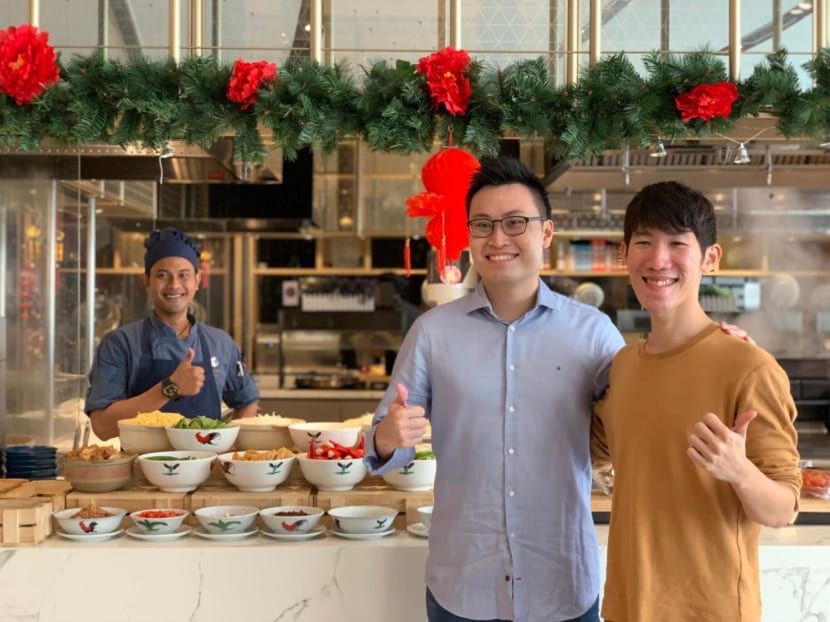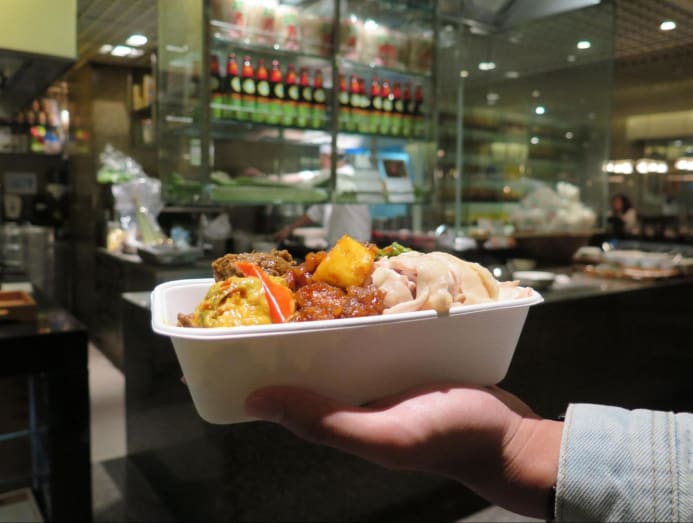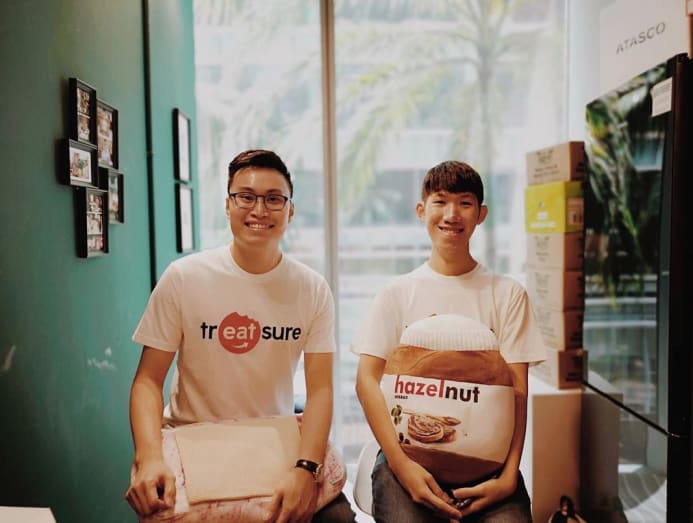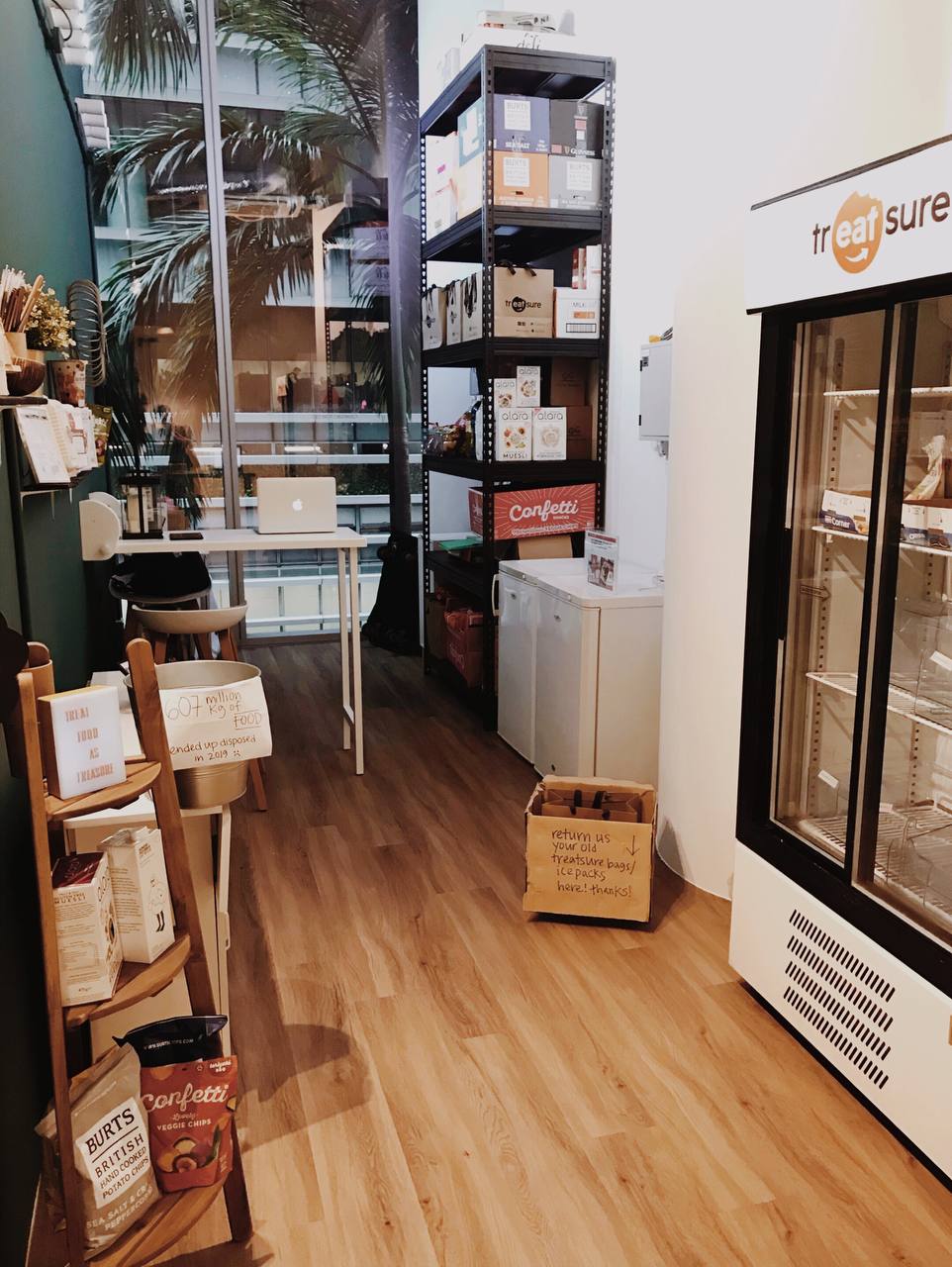Meet treatsure's entrepreneurs who are saving surplus buffet food and ugly groceries in Singapore
With the treatsure app, you can score “takeaways” from hotel buffets and “ugly” groceries at discounted prices.

The enterprising folks behind treatsure: (From right) CEO Preston Wong and CTO Kenneth Ham. (Photo: treatsure)
Lunch in the city centre easily costs S$10, but the same amount can get you a taste of the buffet lines at Fairmont Singapore and Jen Singapore Tanglin by Shangri-La. That is if you have the treatsure app on your phone.
Buffet-in-a-box is the brainchild of treatsure, a tech platform founded to tackle Singapore’s food wastage crisis. Think of it as the buffet equivalent of discounted sushi at closing time. Users can show up in the last stretch of a buffet, pay around S$10 for an empty box, and help themselves to its surplus.
treatsure may owe its social media fame chiefly to this novel concept, but the app was first conceived with the most banal of things in mind – refrigerator maintenance – when chief executive officer Preston Wong watched his mum clear expiring foods in 2016.
“IT WAS UNTHINKABLE AND NOBODY WOULD ACCEPT IT”
“It was just a eureka moment that something can be built, or a platform can be developed, so they don’t go to waste,” said the 33-year-old.
At the time, Wong was completing his second degree in law at the National University of Singapore but had a budding interest in entrepreneurship. Later, he was joined by Kenneth Ham, a like-minded friend from church who was reading computer science in the same school then. Today, his 32-year-old partner in crime is treatsure’s chief technology officer.
“We crashed some entrepreneurship classes in school back then. Even though I was in the law campus and Kenneth was in the computing faculty, we would go over to the business school,” Wong explained. Initially, they envisioned treatsure to be a platform for surplus groceries, but their excitement soon proved short-lived.
“I did surveys by knocking on doors in my neighbourhood, and people were just not interested. They were concerned about getting food poisoning. Back in 2016, it was unthinkable and nobody would accept it. So we moved on to F&B and, true enough, the response was better.”
Buffet-in-a-box got its big break when Grand Hyatt Singapore came on board – a major vote of confidence after treatsure was rejected by several potential partners.

When we spoke, Wong recited the details of their pitch to the 5-star hotel and the exact dates of their soft and official launches like it was yesterday.
“We met Mr Jerome Pagnier and Mr Giree Nair of Grand Hyatt Singapore. They took me to the club lounge, sat me down, and very intently heard me out. They didn’t dismiss it but, being very experienced in the hospitality industry, knew there were challenges to overcome,” he explained.
Food safety was the hotel’s paramount concern. How quickly should their cooked food be consumed? Can a 5-star hotel champion sustainability without jeopardising its branding?
What started as a sales pitch became a succession of brainstorming sessions. Terms and conditions were introduced. Stickers were slapped on boxes to remind consumers of their “best before" timings. Hotel staff were educated to relay these messages. Seafood items like sashimi, mussels, and lobsters, were also left out of the equation.

These safeguards assured Grand Hyatt Singapore to take a chance on them. Once they did, others like Fairmont Singapore and Swissotel The Stamford followed suit. But another hurdle presented itself: Hotels weren’t the only ones who needed convincing.
“When we first launched it, our interns and I gave out free boxes along Orchard Road. It was interesting that nobody was willing to accept that deal. It was so new. Takeaways from buffets were not at all the norm, let alone S$10.70 bento boxes,” said Wong.
“The initial acceptance was slow, but we started seeing office workers bringing their friends along. It got so popular to a point where hotels didn’t know how to respond to the crowd,” added Ham.
PIVOTING IN THE PANDEMIC
In 2019 alone, treatsure’s initial crop of five partners grew to 20. At the same time, Wong and Ham were also branching out to surplus groceries – a move that seems almost prescient in retrospect. Who would’ve guessed that buffet-in-a-box would lose steam entirely in the following year?
“When COVID-19 hit, we had almost no business from our hotel partners but the grocery side of things boomed. We had to manage the surge in demand, which was quite overwhelming during the circuit breaker,” said Wong.

The silver lining culminated in treatsure’s first concept store along Robinson Road, and its opening was perfectly timed with workers returning to their offices.
Before, buyers either opted for delivery or self-collection at various MRT stations. Now, a store reduces both hassle and carbon emissions. If passers-by were lucky, they could even score highly coveted food items like sourdough bread loaves and kyoho grapes.
Along the way, treatsure made a couple of detours – buffet-in-a-box being a particularly rewarding one – but is now coming full circle to the vision that sprouted in Wong’s kitchen five years ago. Asked if this journey has made them food wastage “sheriffs” at home, the founders conceded that their job hazard is inescapable at every turn.
“I was at an event last Friday with catered food and they were asking: 'What can treatsure do about this?' When I go for a wedding dinner with the occasional banquet wastage, they’ll ask the same question,” Wong said.
“When I go back for reservist, sometimes I wonder if I can connect with someone from MINDEF to see whether we can reduce this food waste. Even when we take the MRT and see leftovers at bakeries, we’ll think about how we can help. It’s always at the top of our minds,” added Ham.
“There are a thousand and one problems, but we want to be able to find meaning in whatever we’re solving and work with partners to do that. That has always been our modus operandi.”









